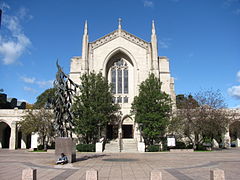Marsh Chapel
| Marsh Chapel | |
|---|---|
 Exterior of chapel | |
 | |
| Location | Boston, Massachusetts |
| Country | United States |
| Denomination | Non-denominational |
| Architecture | |
| Functional status | Active |
| Architect(s) | Ralph Adams Cram |
| Architectural type | Chapel |
| Style | Gothic revival |
| Groundbreaking | 1949 |
| Completed | 1950 |
| Specifications | |
| Height | 18 meters / 59 feet |
| Clergy | |
| Dean | Robert Hill |
Marsh Chapel is a building on the campus of Boston University used as the official place of worship of the school, named after former president of BU, Daniel L. Marsh, who was also a Methodist minister.[1] The building is Gothic in style. While Methodism, the university's historical denomination, exerts a great influence on the chapel, it is formally non-denominational. The current dean of Marsh Chapel is Rev. Dr. Robert Hill, an ordained elder in The United Methodist Church.[2]
History
Plans for a riverside chapel at the university were made as early as 1920, when the university purchased the 15-acre (0.061 km2) Charles River Campus and commissioned a master plan from architect Ralph Adams Cram. Originally, the chapel was to be complemented by the Alexander Graham Bell tower, a Gothic Revival administrative structure named for Alexander Graham Bell.[3] The chapel's completion was stalled by the Great Depression and Second World War, after which Ralph Adams Cram was selected as its architect. The building was dedicated in 1950, heralding the end of a period of Collegiate Gothic construction on American campuses.
Good Friday experiment
It was the site where the famed Marsh Chapel Experiment took place. Researchers involved included Walter Pahnke, Harvard professor and later psychedelic guru Timothy Leary, and Richard Alpert (who would later become known as Ram Dass).
Influence on Civil Rights Movement
Between 1953 and 1965, African-American theologian Howard Thurman presided the chapel as its dean.[4] Thurman exerted an enormous influence on the work of Civil Rights Movement leader Martin Luther King, Jr., who studied at Boston University.
Other notable figures associated with Marsh Chapel
- Robert Cummings Neville, one of the Boston Confucians, served as a dean of the chapel
References
- ^ http://www.bu.edu/today/node/9350/
- ^ http://www.bu.edu/today/2009/icons-among-us-marsh-chapel/
- ^ Lasser, Allan. "The Campus That Could Have Been". Buquad.com. Retrieved 4 December 2014.
- ^ http://www.bu.edu/today/node/12669
